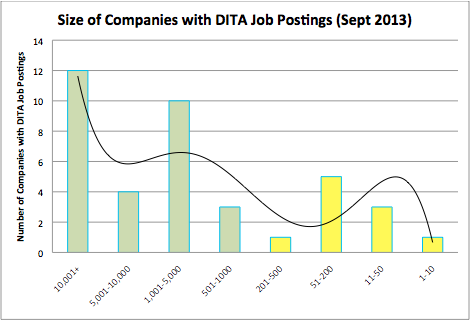
- Internet
- 13.02.2019
- EN
yellowpencil: What size is DITA and where is it going?
A 2 minute read, written by Keith
September 27, 2013

Welcome back! Let's continue our discussion about DITA and how it's maturing. One other thing that emerged from the job posting information I discussed in the past articles from this DITA series was that it matched a pattern I have seen before. It suggested that DITA is a "one size fits all" solution. The same pattern is seen here, with very-large, large, and mid-size firms being those who are seeking people with DITA experience the most:

As you can see there is a continuum of DITA usage, with firms of all sizes seeking people with DITA experience, but with three peaks, which occur with the very large (10,000+ employees), large (1,001-5,000 employees) and medium-sized (51-200 employees) firms. I would be interested in hearing from others as to why they think this pattern exists. Here are my thoughts:
- Small firms benefit from the more efficient processes (content reuse, de-siloed writers) that DITA has to offer, and those benefits are more pronounced with small to mid-sized firms.
- Large and very-large firms reap the same benefits in addition to others (reduced localization costs, content reuse across a wider range of products, exchanging DITA-based content with partners) that come with scale.
In these cases it just “makes sense” to do things using DITA. I suspect that very small firms (1-10 employees) adopt DITA because of the relatively low-cost of the tools involved, but I have a harder time explaining the relatively low adoption pattern that exists with medium-to-large (201-1000 employee) and medium-large (5,001-10,000) firms. I am guessing that firms of these sizes are themselves going through a maturation process where old-school/brute-force methods of doing documentation still hold sway. If anyone has any other thoughts on this why this reoccurring pattern exists, please leave your comments below!
So where is DITA now and where is it going?
DITA continues to be a sought-after skill among technical writers, with increasing demand. While there are other technical writing standards out there, it is by far the most popular, and may have helped kill off DocBook. The industry as a whole appears to have entered a more mature phase, though there are still a sizable number of firms seeking to migrate to DITA, so there are still jobs out there for people looking to help with the transition, but that type of opportunity is getting smaller over time. DITA still dominates in the software/IT sectors, but it is increasingly seeing usage outside of those two "core" sectors, and the relative sizes of firms looking for those with DITA experience follows a continuing trend.
Where will DITA adoption be a year from now? While I hesitate to pull out my crystal ball (after all, those things are fragile) I think I can safely make the following predictions based on the trends observed:
- DITA adoption will continue to grow slowly but steadily
- More firms will enter the mature phase of DITA adoption
- The DITA tool market will likely begin to see signs of consolidation with select players taking the lead, though there is still room for firms who can bring strong and compelling products to DITA authors
- DITA becoming the de facto choice for documentation within software/IT firms
- Continued growth of DITA outside of its software/IT core.
Let’s meet back in a year and see how many of these predictions pan out. In the meantime, keep watching this space for more DITA news and analysis.
Yellow Pencil (www.yellowpencil.com) provides DITA training services along with information architecture and content strategy services for firms looking to move to structured content for their technical writing and web content teams.
Source: What size is DITA and where is it going?
© copyright 2013 by yellowpencil